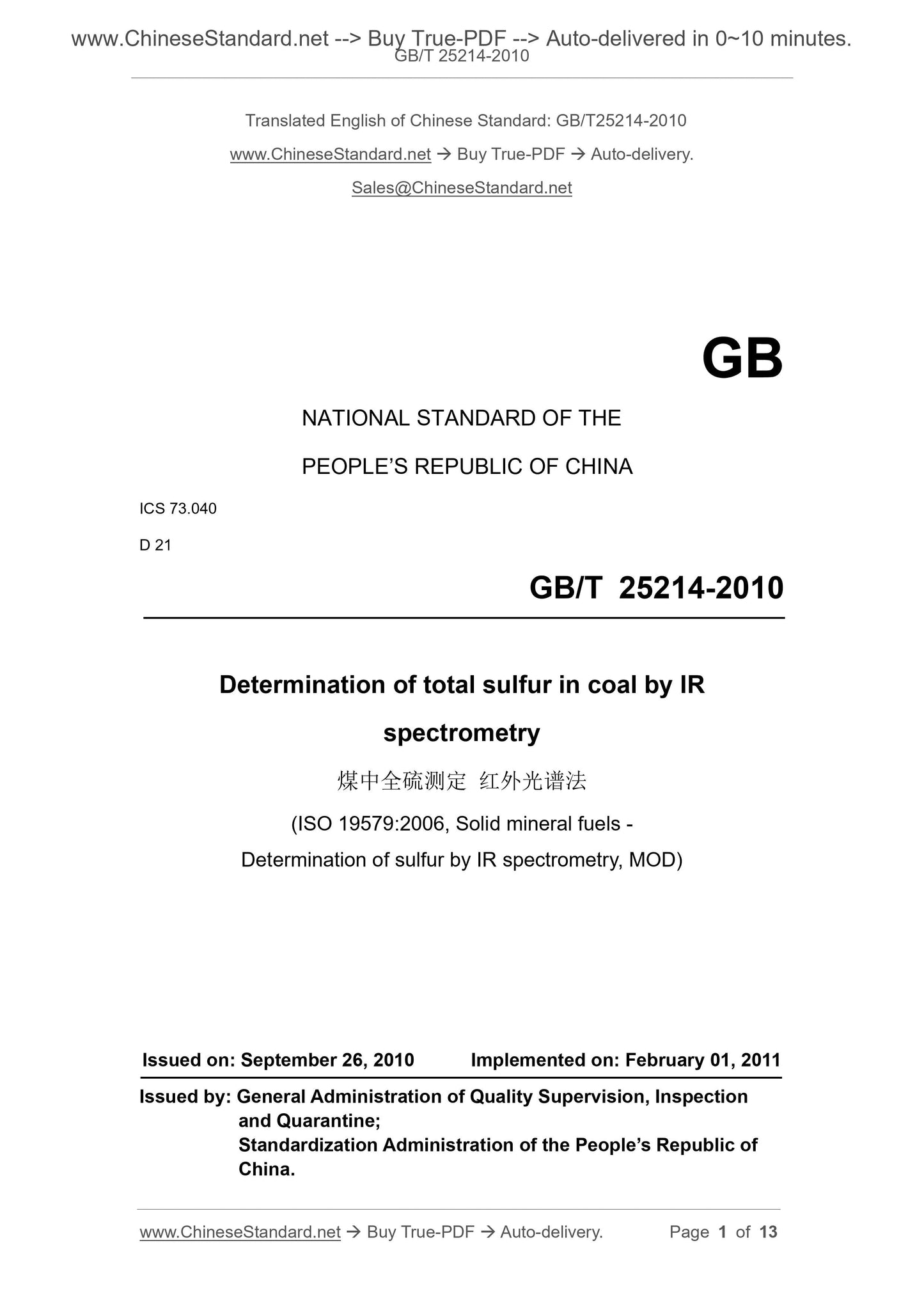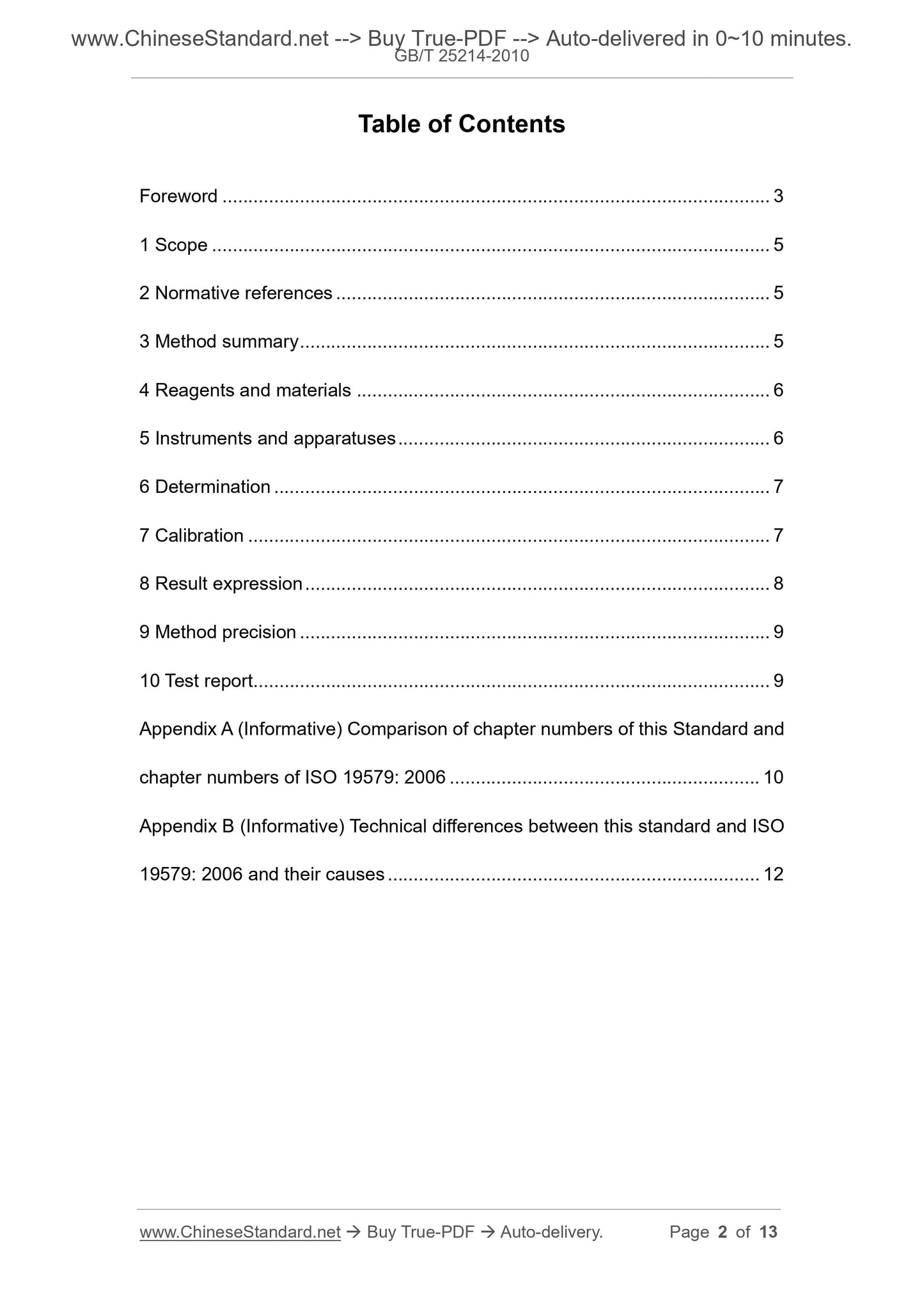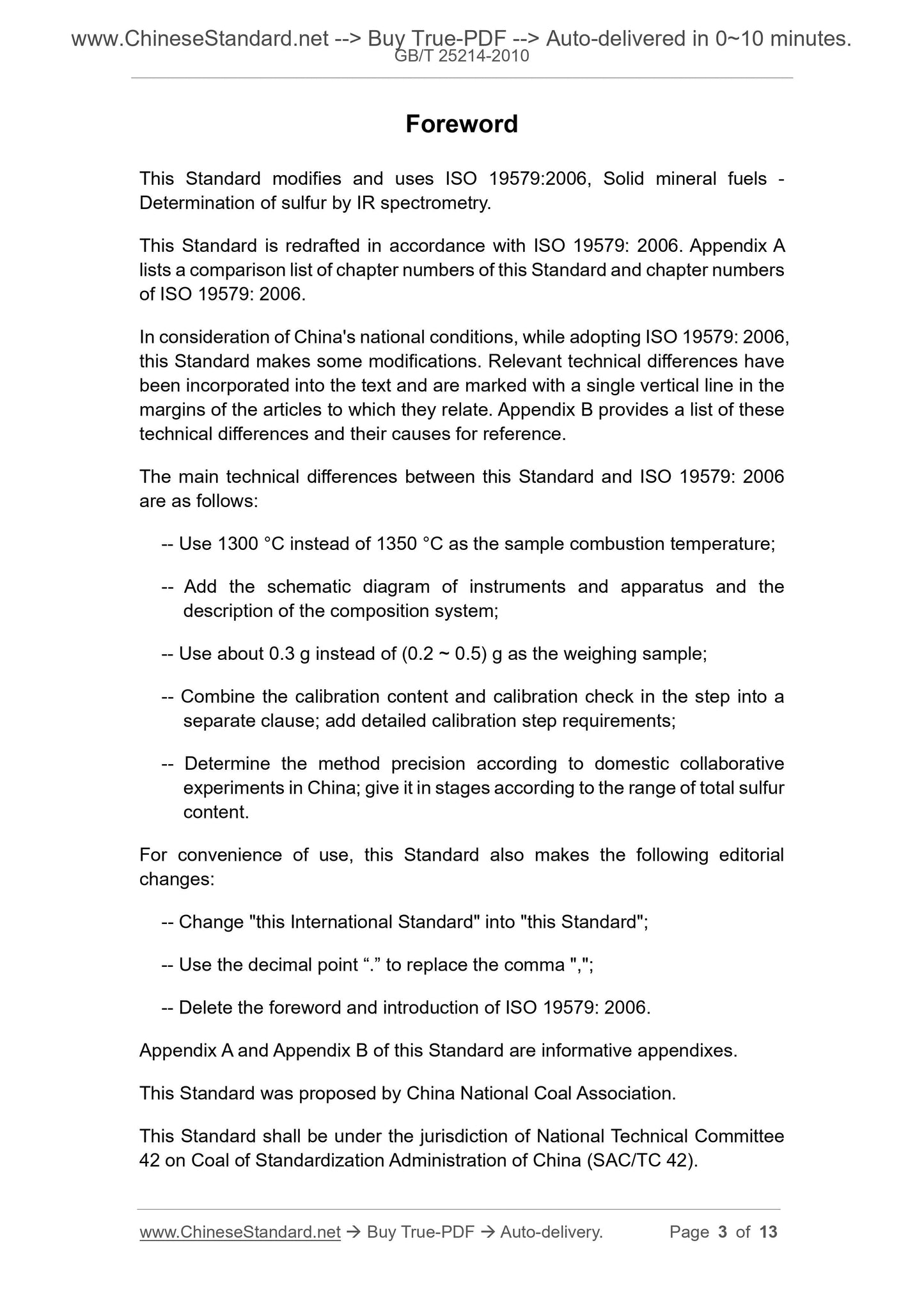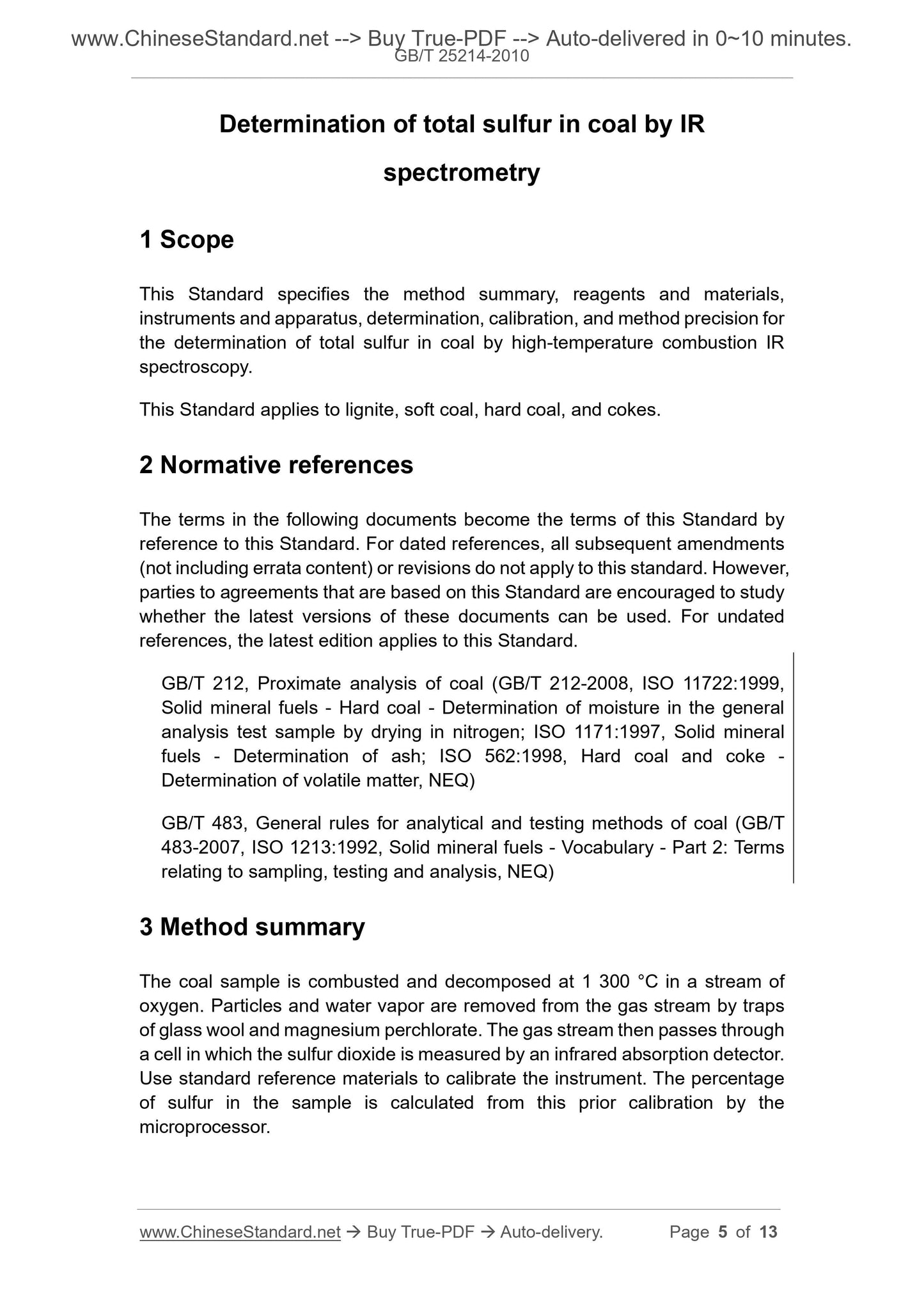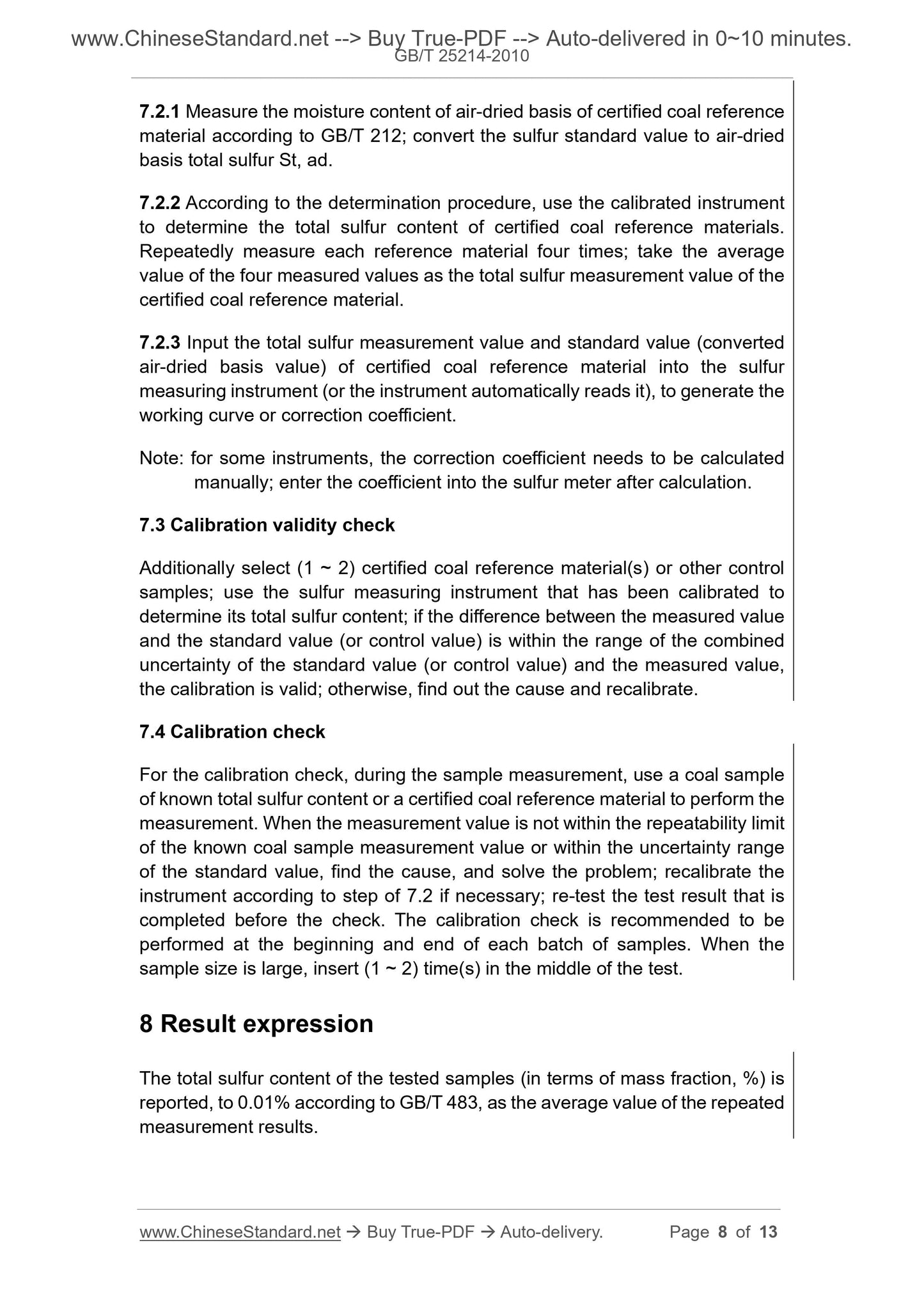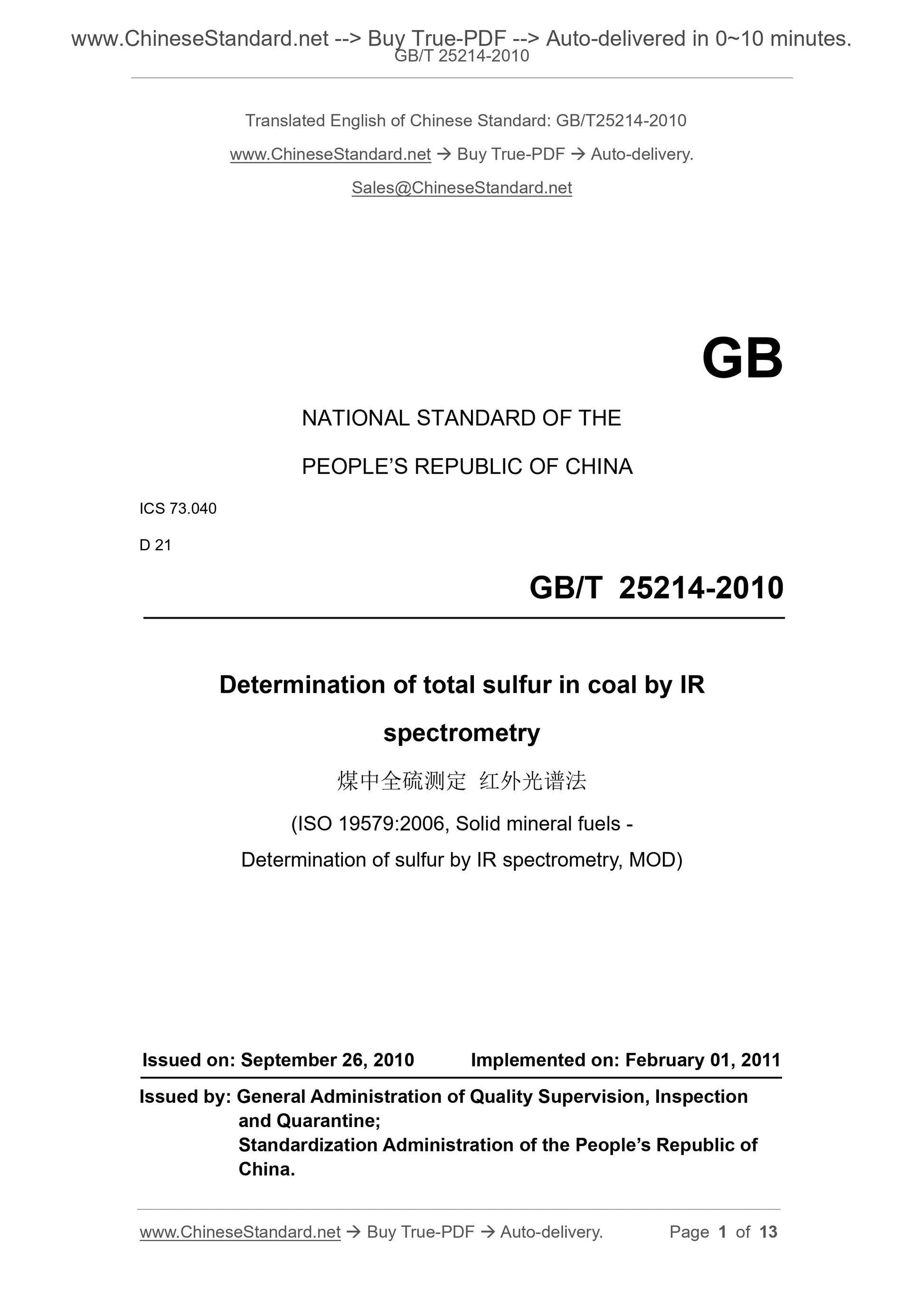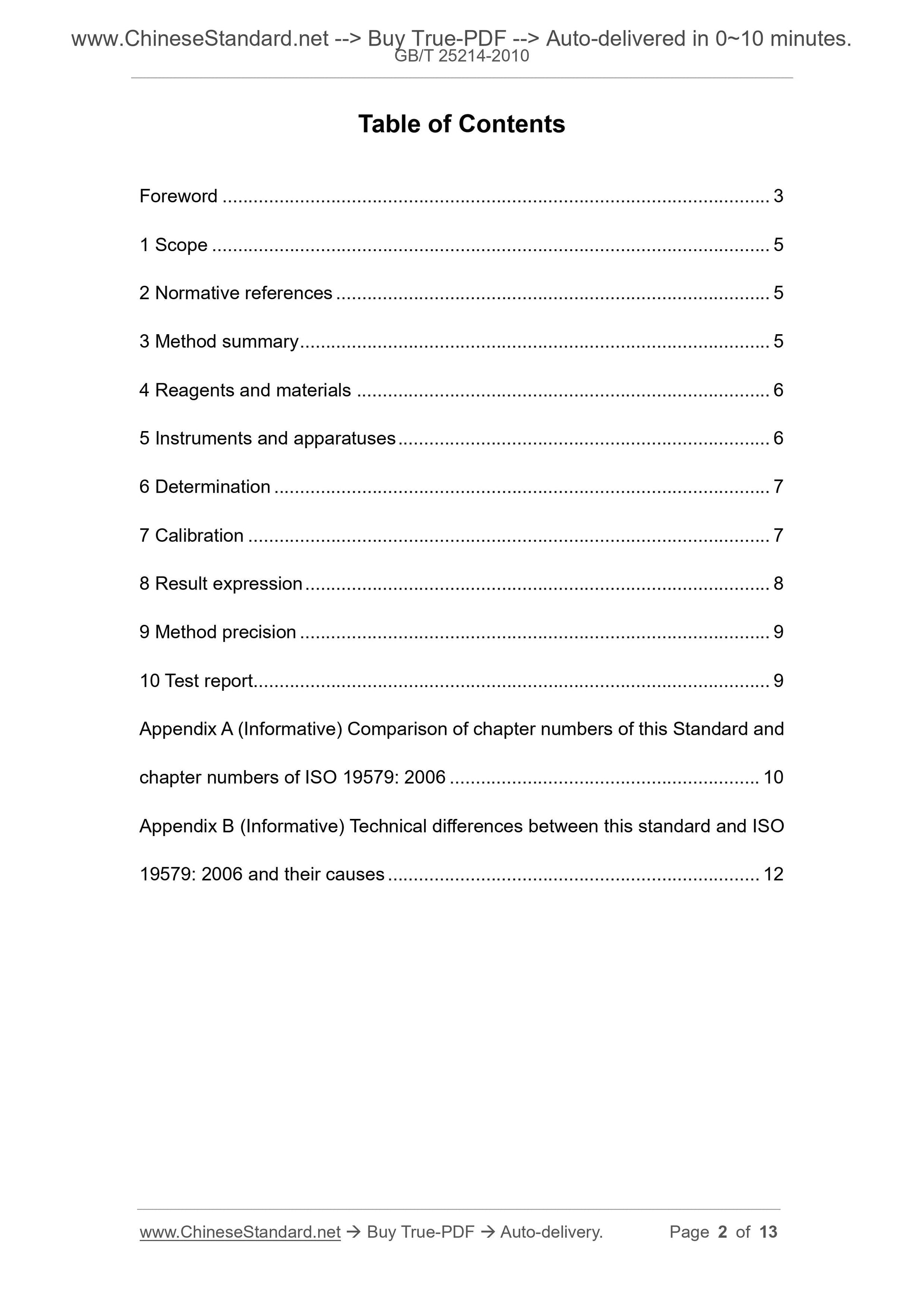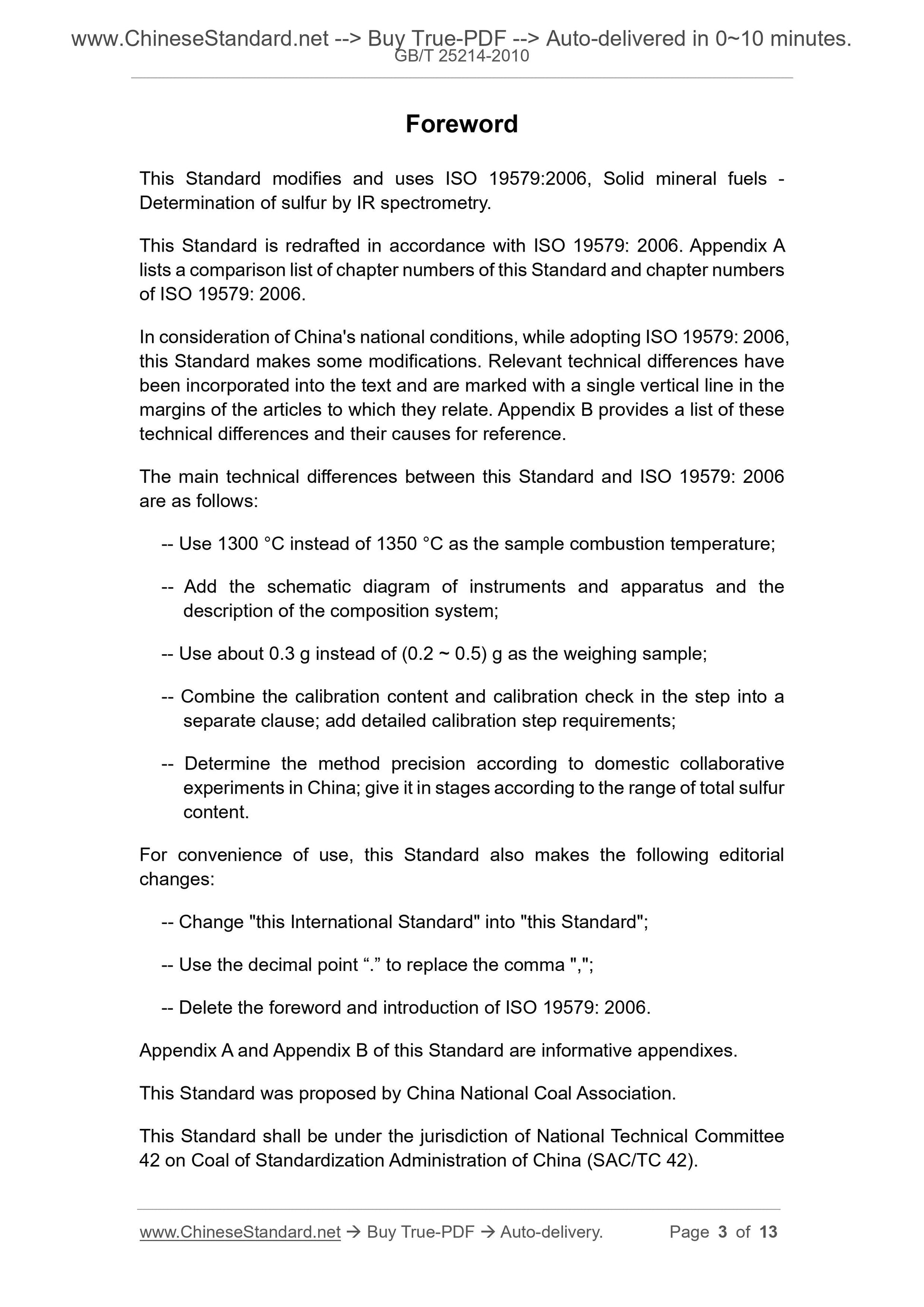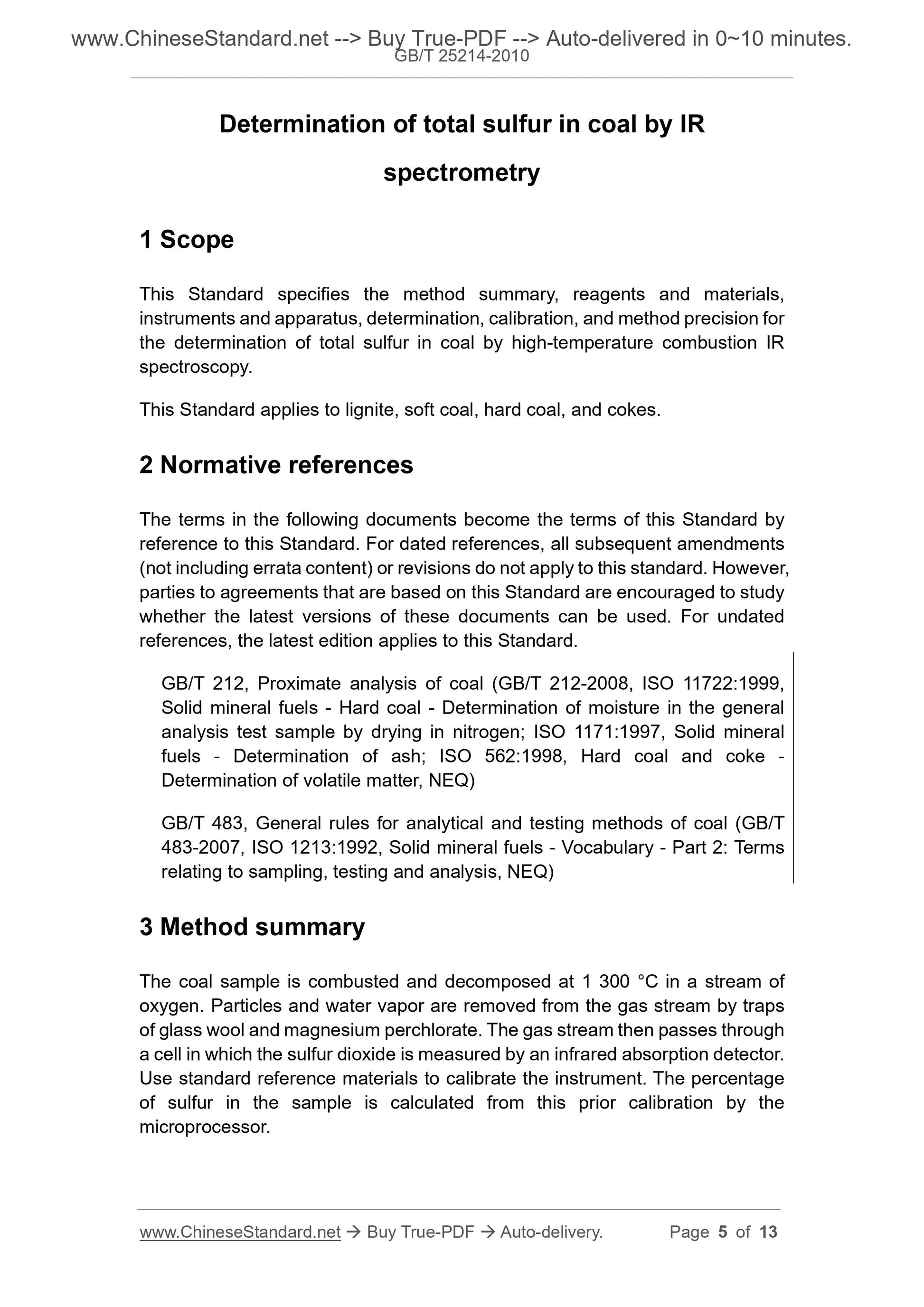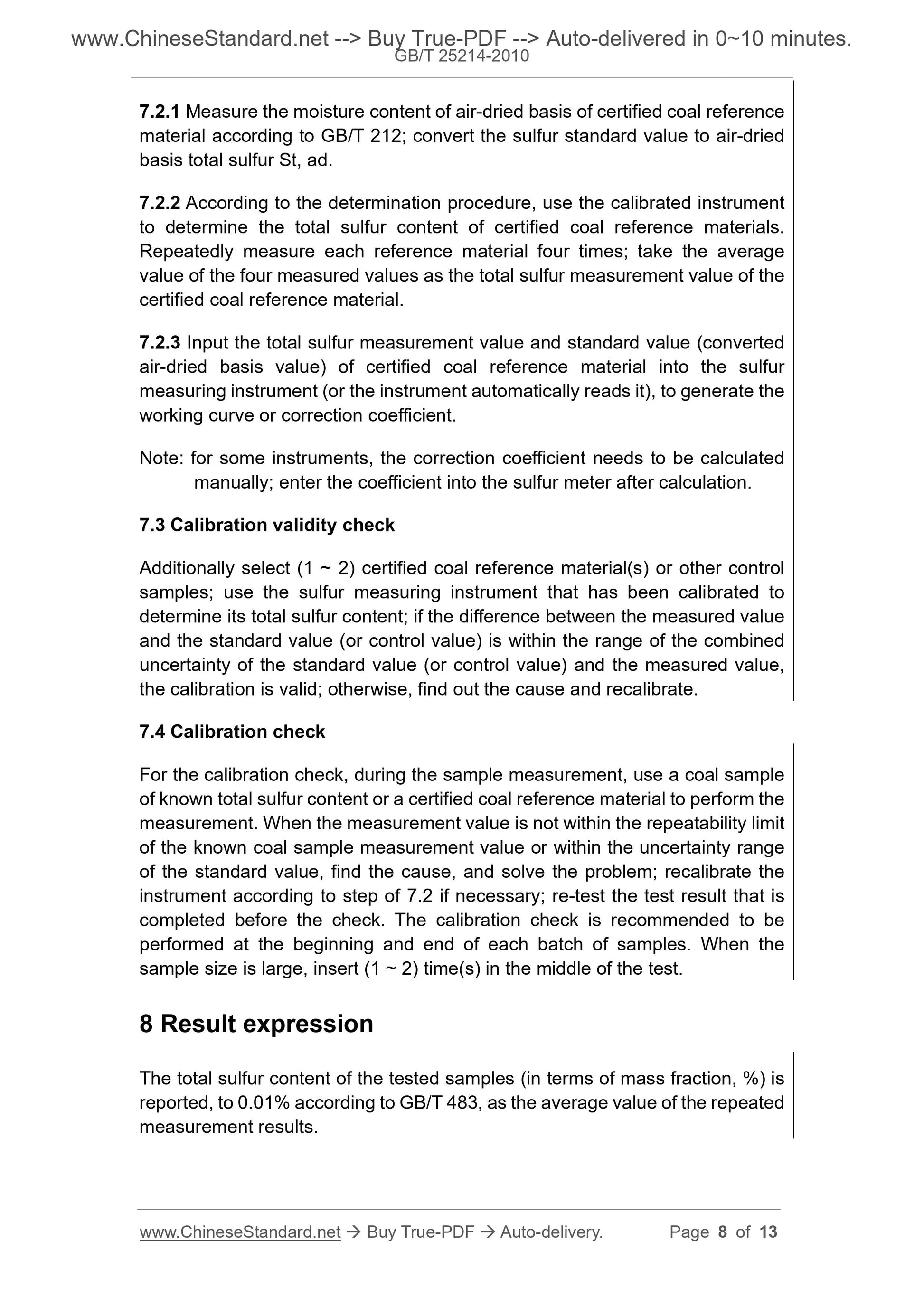1
/
of
5
PayPal, credit cards. Download editable-PDF and invoice in 1 second!
GB/T 25214-2010 English PDF (GBT25214-2010)
GB/T 25214-2010 English PDF (GBT25214-2010)
Regular price
$70.00 USD
Regular price
Sale price
$70.00 USD
Unit price
/
per
Shipping calculated at checkout.
Couldn't load pickup availability
Delivery: 3 seconds. Download true-PDF + Invoice.
Get QUOTATION in 1-minute: Click GB/T 25214-2010
Historical versions: GB/T 25214-2010
Preview True-PDF (Reload/Scroll if blank)
GB/T 25214-2010: Determination of total sulfur in coal by IR spectrometry
GB/T 25214-2010
NATIONAL STANDARD OF THE
PEOPLE’S REPUBLIC OF CHINA
ICS 73.040
D 21
Determination of total sulfur in coal by IR
spectrometry
(ISO 19579:2006, Solid mineral fuels -
Determination of sulfur by IR spectrometry, MOD)
ISSUED ON: SEPTEMBER 26, 2010
IMPLEMENTED ON: FEBRUARY 01, 2011
Issued by: General Administration of Quality Supervision, Inspection
and Quarantine;
Standardization Administration of the People’s Republic of
China.
Table of Contents
Foreword ... 3
1 Scope ... 5
2 Normative references ... 5
3 Method summary ... 5
4 Reagents and materials ... 6
5 Instruments and apparatuses ... 6
6 Determination ... 7
7 Calibration ... 7
8 Result expression ... 8
9 Method precision ... 9
10 Test report ... 9
Appendix A (Informative) Comparison of chapter numbers of this Standard and
chapter numbers of ISO 19579: 2006 ... 10
Appendix B (Informative) Technical differences between this standard and ISO
19579: 2006 and their causes ... 12
Foreword
This Standard modifies and uses ISO 19579:2006, Solid mineral fuels -
Determination of sulfur by IR spectrometry.
This Standard is redrafted in accordance with ISO 19579: 2006. Appendix A
lists a comparison list of chapter numbers of this Standard and chapter numbers
of ISO 19579: 2006.
In consideration of China's national conditions, while adopting ISO 19579: 2006,
this Standard makes some modifications. Relevant technical differences have
been incorporated into the text and are marked with a single vertical line in the
margins of the articles to which they relate. Appendix B provides a list of these
technical differences and their causes for reference.
The main technical differences between this Standard and ISO 19579: 2006
are as follows:
-- Use 1300 °C instead of 1350 °C as the sample combustion temperature;
-- Add the schematic diagram of instruments and apparatus and the
description of the composition system;
-- Use about 0.3 g instead of (0.2 ~ 0.5) g as the weighing sample;
-- Combine the calibration content and calibration check in the step into a
separate clause; add detailed calibration step requirements;
-- Determine the method precision according to domestic collaborative
experiments in China; give it in stages according to the range of total sulfur
content.
For convenience of use, this Standard also makes the following editorial
changes:
-- Change "this International Standard" into "this Standard";
-- Use the decimal point “.” to replace the comma ",";
-- Delete the foreword and introduction of ISO 19579: 2006.
Appendix A and Appendix B of this Standard are informative appendixes.
This Standard was proposed by China National Coal Association.
This Standard shall be under the jurisdiction of National Technical Committee
42 on Coal of Standardization Administration of China (SAC/TC 42).
Determination of total sulfur in coal by IR
spectrometry
1 Scope
This Standard specifies the method summary, reagents and materials,
instruments and apparatus, determination, calibration, and method precision for
the determination of total sulfur in coal by high-temperature combustion IR
spectroscopy.
This Standard applies to lignite, soft coal, hard coal, and cokes.
2 Normative references
The terms in the following documents become the terms of this Standard by
reference to this Standard. For dated references, all subsequent amendments
(not including errata content) or revisions do not apply to this standard. However,
parties to agreements that are based on this Standard are encouraged to study
whether the latest versions of these documents can be used. For undated
references, the latest edition applies to this Standard.
GB/T 212, Proximate analysis of coal (GB/T 212-2008, ISO 11722:1999,
Solid mineral fuels - Hard coal - Determination of moisture in the general
analysis test sample by drying in nitrogen; ISO 1171:1997, Solid mineral
fuels - Determination of ash; ISO 562:1998, Hard coal and coke -
Determination of volatile matter, NEQ)
GB/T 483, General rules for analytical and testing methods of coal (GB/T
483-2007, ISO 1213:1992, Solid mineral fuels - Vocabulary - Part 2: Terms
relating to sampling, testing and analysis, NEQ)
3 Method summary
The coal sample is combusted and decomposed at 1 300 °C in a stream of
oxygen. Particles and water vapor are removed from the gas stream by traps
of glass wool and magnesium perchlorate. The gas stream then passes through
a cell in which the sulfur dioxide is measured by an infrared absorption detector.
Use standard reference materials to calibrate the instrument. The percentage
of sulfur in the sample is calculated from this prior calibration by the
microprocessor.
7.2.1 Measure the moisture content of air-dried basis of certified coal reference
material according to GB/T 212; convert the sulfur standard value to air-dried
basis total sulfur St, ad.
7.2.2 According to the determination procedure, use the calibrated instrument
to determine the total sulfur content of certified coal reference materials.
Repeatedly measure each reference material four times; take the average
value of the four measured values as the total sulfur measurement value of the
certified coal reference material.
7.2.3 Input the total sulfur measurement value and standard value (converted
air-dried basis value) of certified coal reference material into the sulfur
measuring instrument (or the instrument automatically reads it), to generate the
working curve or correction coefficient.
Note: for some instruments, the correction coefficient needs to be calculated
manually; enter the coefficient into the sulfur meter after calculation.
7.3 Calibration validity check
Additionally select (1 ~ 2) certified coal reference material(s) or other control
samples; use the sulfur measuring instrument that has been calibrated to
determine its total sulfur content; if the difference between the measured value
and the standard value (or control value) is within the range of the combined
uncertainty of the standard value (or control value) and the measured value,
the calibration is valid; otherwise, find out the cause and recalibrate.
7.4 Calibration check
For the calibration check, during the sample measurement, use a coal sample
of known total sulfur content or a certified coal reference material to perform the
measurement. When the measurement value is not within the repeatability limit
of the known coal sample measurement value or within the uncertainty range
of the standard value, find the cause, and solve the problem; recalibrate the
instrument according to step of 7.2 if necessary; re-test the test result that is
completed before the check. The calibration check is recommended to be
performed at the beginning and end of each batch of samples. When the
sample size is large, insert (1 ~ 2) time(s) in the middle of the test.
8 Result expression
The total sulfur content of the tested samples (in terms of mass fraction, %) is
reported, to 0.01% according to GB/T 483, as the average value of the repeated
measurement results.
Get QUOTATION in 1-minute: Click GB/T 25214-2010
Historical versions: GB/T 25214-2010
Preview True-PDF (Reload/Scroll if blank)
GB/T 25214-2010: Determination of total sulfur in coal by IR spectrometry
GB/T 25214-2010
NATIONAL STANDARD OF THE
PEOPLE’S REPUBLIC OF CHINA
ICS 73.040
D 21
Determination of total sulfur in coal by IR
spectrometry
(ISO 19579:2006, Solid mineral fuels -
Determination of sulfur by IR spectrometry, MOD)
ISSUED ON: SEPTEMBER 26, 2010
IMPLEMENTED ON: FEBRUARY 01, 2011
Issued by: General Administration of Quality Supervision, Inspection
and Quarantine;
Standardization Administration of the People’s Republic of
China.
Table of Contents
Foreword ... 3
1 Scope ... 5
2 Normative references ... 5
3 Method summary ... 5
4 Reagents and materials ... 6
5 Instruments and apparatuses ... 6
6 Determination ... 7
7 Calibration ... 7
8 Result expression ... 8
9 Method precision ... 9
10 Test report ... 9
Appendix A (Informative) Comparison of chapter numbers of this Standard and
chapter numbers of ISO 19579: 2006 ... 10
Appendix B (Informative) Technical differences between this standard and ISO
19579: 2006 and their causes ... 12
Foreword
This Standard modifies and uses ISO 19579:2006, Solid mineral fuels -
Determination of sulfur by IR spectrometry.
This Standard is redrafted in accordance with ISO 19579: 2006. Appendix A
lists a comparison list of chapter numbers of this Standard and chapter numbers
of ISO 19579: 2006.
In consideration of China's national conditions, while adopting ISO 19579: 2006,
this Standard makes some modifications. Relevant technical differences have
been incorporated into the text and are marked with a single vertical line in the
margins of the articles to which they relate. Appendix B provides a list of these
technical differences and their causes for reference.
The main technical differences between this Standard and ISO 19579: 2006
are as follows:
-- Use 1300 °C instead of 1350 °C as the sample combustion temperature;
-- Add the schematic diagram of instruments and apparatus and the
description of the composition system;
-- Use about 0.3 g instead of (0.2 ~ 0.5) g as the weighing sample;
-- Combine the calibration content and calibration check in the step into a
separate clause; add detailed calibration step requirements;
-- Determine the method precision according to domestic collaborative
experiments in China; give it in stages according to the range of total sulfur
content.
For convenience of use, this Standard also makes the following editorial
changes:
-- Change "this International Standard" into "this Standard";
-- Use the decimal point “.” to replace the comma ",";
-- Delete the foreword and introduction of ISO 19579: 2006.
Appendix A and Appendix B of this Standard are informative appendixes.
This Standard was proposed by China National Coal Association.
This Standard shall be under the jurisdiction of National Technical Committee
42 on Coal of Standardization Administration of China (SAC/TC 42).
Determination of total sulfur in coal by IR
spectrometry
1 Scope
This Standard specifies the method summary, reagents and materials,
instruments and apparatus, determination, calibration, and method precision for
the determination of total sulfur in coal by high-temperature combustion IR
spectroscopy.
This Standard applies to lignite, soft coal, hard coal, and cokes.
2 Normative references
The terms in the following documents become the terms of this Standard by
reference to this Standard. For dated references, all subsequent amendments
(not including errata content) or revisions do not apply to this standard. However,
parties to agreements that are based on this Standard are encouraged to study
whether the latest versions of these documents can be used. For undated
references, the latest edition applies to this Standard.
GB/T 212, Proximate analysis of coal (GB/T 212-2008, ISO 11722:1999,
Solid mineral fuels - Hard coal - Determination of moisture in the general
analysis test sample by drying in nitrogen; ISO 1171:1997, Solid mineral
fuels - Determination of ash; ISO 562:1998, Hard coal and coke -
Determination of volatile matter, NEQ)
GB/T 483, General rules for analytical and testing methods of coal (GB/T
483-2007, ISO 1213:1992, Solid mineral fuels - Vocabulary - Part 2: Terms
relating to sampling, testing and analysis, NEQ)
3 Method summary
The coal sample is combusted and decomposed at 1 300 °C in a stream of
oxygen. Particles and water vapor are removed from the gas stream by traps
of glass wool and magnesium perchlorate. The gas stream then passes through
a cell in which the sulfur dioxide is measured by an infrared absorption detector.
Use standard reference materials to calibrate the instrument. The percentage
of sulfur in the sample is calculated from this prior calibration by the
microprocessor.
7.2.1 Measure the moisture content of air-dried basis of certified coal reference
material according to GB/T 212; convert the sulfur standard value to air-dried
basis total sulfur St, ad.
7.2.2 According to the determination procedure, use the calibrated instrument
to determine the total sulfur content of certified coal reference materials.
Repeatedly measure each reference material four times; take the average
value of the four measured values as the total sulfur measurement value of the
certified coal reference material.
7.2.3 Input the total sulfur measurement value and standard value (converted
air-dried basis value) of certified coal reference material into the sulfur
measuring instrument (or the instrument automatically reads it), to generate the
working curve or correction coefficient.
Note: for some instruments, the correction coefficient needs to be calculated
manually; enter the coefficient into the sulfur meter after calculation.
7.3 Calibration validity check
Additionally select (1 ~ 2) certified coal reference material(s) or other control
samples; use the sulfur measuring instrument that has been calibrated to
determine its total sulfur content; if the difference between the measured value
and the standard value (or control value) is within the range of the combined
uncertainty of the standard value (or control value) and the measured value,
the calibration is valid; otherwise, find out the cause and recalibrate.
7.4 Calibration check
For the calibration check, during the sample measurement, use a coal sample
of known total sulfur content or a certified coal reference material to perform the
measurement. When the measurement value is not within the repeatability limit
of the known coal sample measurement value or within the uncertainty range
of the standard value, find the cause, and solve the problem; recalibrate the
instrument according to step of 7.2 if necessary; re-test the test result that is
completed before the check. The calibration check is recommended to be
performed at the beginning and end of each batch of samples. When the
sample size is large, insert (1 ~ 2) time(s) in the middle of the test.
8 Result expression
The total sulfur content of the tested samples (in terms of mass fraction, %) is
reported, to 0.01% according to GB/T 483, as the average value of the repeated
measurement results.
Share
